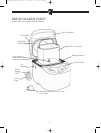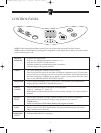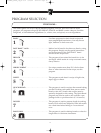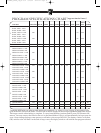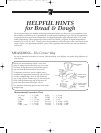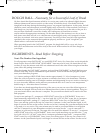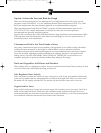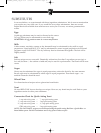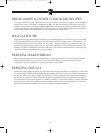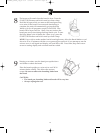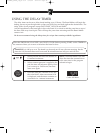
13
the 10 minutes the yeast has multiplied to the
1
/2 cups mark, it is very active. The yeast mixture may
be used in your Bread Maker in a recipe that calls for 1
1
/2 teaspoons or more of yeast. Remember to
adjust your recipe for the
1
/4 cup of water and 1
1
/2 teaspoons of yeast used in the test. The sugar does
not need to be adjusted.
Flour: Bread Flour is Essential for Bread
All types of flour are affected by many factors, such as milling grades, moisture content, length of
storage and manufacturing process. Adjustments to the recipes may need to be made to compensate
for climactic changes in different regions to ensure an excellent loaf.
Bread flour is a definite necessity. Milled from hard winter or spring wheat, it has a higher protein
content that makes it more durable than all-purpose flour. The protein, when mixed with liquid,
becomes gluten.
When kneaded, gluten becomes elastic and gives the bread better structure. In contrast, all-purpose
flour, milled from a combination of soft and hard wheat, becomes elastic too easily for use in a Bread
Maker and quickly loses its ability to stretch well. As a result, bread made from all-purpose flour will
be smaller and more dense. Several well-known mills now market bread flour. It is labeled bread
flour on the package and is available at grocery stores.
Wheat is the only grain that contains the type of protein that becomes elastic when kneaded. Other
flours, such as rye, barley, oats, soy, rice and buckwheat add flavor and fiber to breads but do not
add structure to the dough. Therefore, wheat flour is essential as a base when making bread.
Vital Wheat Gluten is produced by processing white flour one more step. White flour contains both
protein and starch, and mills now can remove most of the starch leaving only the protein (gluten).
When gluten is added to recipes containing whole grain flours, it improves the volume and shape of
the loaf significantly. Many grocery stores stock gluten in the flour section. Health food and nutrition
centers also carry this item.
Flour is best kept in an airtight container. If you are storing the flour for a long period of time, you
may want to keep it in the freezer as the refrigerator tends to dry it out. Whole grain wheat flours,
which have a higher oil content, will become rancid much more quickly than white flour and should
always be kept in the freezer. Be sure, however, to allow all flours to return to room temperature
before placing in the Bread Maker.
Fat: Dough Enhancer and Conditioner
Our recipes were developed using vegetable oil. You may use any type of oil or substitute in equal
proportions solid shortening or real butter (divide them into small pieces). We have found no
noticeable difference in flavor but the crust may be more crisp with real butter. We do not
recommend the use of margarine as it tends to make the crust tough.
Breadman_TR520_IB_23-3-07 3/23/07 2:44 PM Page 15




